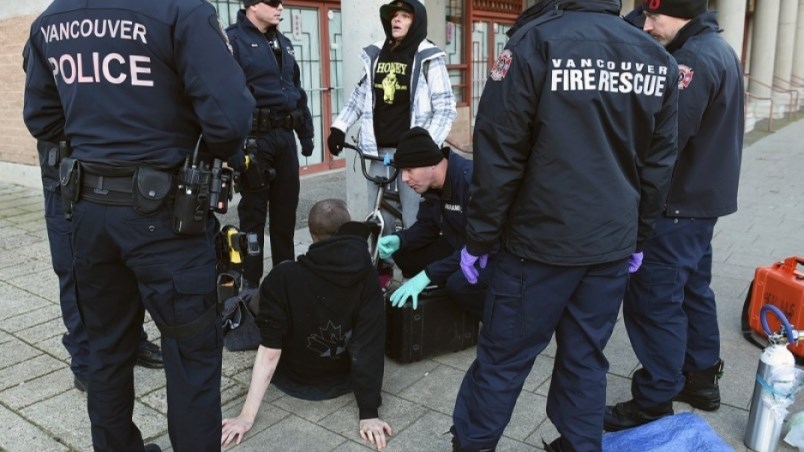The BC Coroners Service says illicit drugs have killed some 1,827 British Columbians in the first 10 months of 2022.
On Nov. 30, the service said 179 people died from illicit drug use in October. That’s 5.8 deaths per day.
The new numbers mean at least 10,688 B.C. residents have died since the provincial public-health emergency into substance-related harms was first declared in April 2016.
The death rate peaked in 2021, with 2,267 people losing their lives.
"Despite the efforts of many, this public-health emergency continues to devastate families throughout our province," chief coroner Lisa Lapointe said in a statement. "The increased toxicity and variability of the illicit drug supply has created an environment where everyone who uses substances is at risk."
The coroner added the vulnerability is greater for those who live outside the urban centres where the limited number of safer supply programs are currently focused.
The latest data reflects the continued dangers toxic drugs pose to substance users, the statement said.
The report noted the 453 deaths in Vancouver so far this year account for 22 per cent of fatalities. Prince George and Nanaimo have already recorded more illicit drug-related deaths in 2022 than in any previous year, and both the Island and Northern Health authorities are currently trending toward record losses of life for 2022.
Illicit drug toxicity continues to be the leading cause of unnatural death in B.C., second only to cancers in terms of years of life lost.
Lapointe reiterated that the recommendations from both the standing committee on health and two BC Coroners Service death review panels are clear.
"We must create a comprehensive continuum of care that supports people with substance-use disorders, and we must improve access to evidence-based options for treatment and recovery," she said. “Most importantly, as those reports recommended, it is imperative that access to safer supply is available in all areas of the province.”
Preliminary data for 2022 has found fentanyl or its analogues have been detected in 81% of all illicit drug toxicity deaths. In 2021, fentanyl or its analogues were detected in 86% of deaths.
Post-mortem toxicology results suggest a greater number of cases with extreme fentanyl concentrations, from November 2021 to August 2022, compared with previous months.
Data for 2016-2020 shows smoking drugs has moved past injecting as the preferred method of use.
Minister's response
"The pain felt by those who have lost their loved ones to this public-health crisis is profound," said Minister of Mental Health and Addictions Sheila Malcolmson. "My heart goes out to the families, friends and communities that are grieving these losses."
Malcolmson said the government continues to expand its response to the public-health emergency to stem the loss of life.
"While we have been adding new treatment and recovery services, expanding overdose prevention and working to end stigma about addiction, the increasing illicit drug toxicity has taken more lives," she said.
Malcolmson noted a Kamloops treatment centre — A New Tomorrow — opened earlier in November. It offers publicly funded substance-use treatment for adults and youth.
"On Vancouver Island, Coastal Sage Healing Centre is welcoming women and non-binary people to its treatment centre, offering culturally safe and trauma-informed services. We know there is more work to do," she added.
The minister said the government will release its Adult Substance Use System of Care Framework later this week. It was one of the recommendations of the death review panel.
"The framework was built on close collaboration and consultation with more than 300 partners and contributors across health and social sectors. It will guide the development of new models of substance-use care, where every person's needs are met at every point of their recovery journey," Malcolmson said.
B.C. Green Party Leader Sonia Furstenau said Premier David Eby needs to make clear what he intends to do to address the death toll.
"This government is currently not doing enough to reduce the harms caused by toxic drugs," she said. “If Premier Eby truly wants to save lives, he would introduce widely accessible safe supply."
Fursteneau said regulation of treatment centres also needs to be addressed.
“The premier has spoken about forced treatment for people who use drugs, and has said very little on safe supply. Studies are clear that people face an increased risk of death immediately following forced treatment," she said.
"Add to that forced treatment makes people even less likely to seek services at a later date, and treatment centres remain unregulated and without standards of care. Forced treatment will not result in fewer people dying from toxic drugs," Furstenau said.
Key points from the latest report
• In 2022, 70 per cent of those dying were between the ages 30 and 59, and 78 per cent were male.
• Communities reporting the highest number of illicit drug toxicity deaths in 2022 are Vancouver, Surrey, and Greater Victoria.
• By health authority in 2022, the highest number of illicit drug toxicity deaths were in the Fraser and Vancouver Coastal Health authorities (547 and 511 deaths, respectively), making up 58 per cent of all such deaths.
• By health authority in 2022, the highest rates of death have been in Northern Health (56 deaths per 100,000 individuals) and Vancouver Coastal Health (49 per 100,000). Overall, the rate in B.C. is 42 deaths per 100,000 individuals in 2022.
• By Health Service Delivery Area in 2022, the highest rates have been in Vancouver, Northwest, Northern Interior, Thompson Cariboo and Fraser East.
• By Local Health Area in 2022, the highest rates were in Lillooet, Cowichan Valley West, Terrace, Alberni/Clayoquot and Merritt.
• No deaths have been reported at supervised consumption or drug overdose prevention sites.
• Analysis of post-mortem toxicology results shows no indication that prescribed safe supply is contributing to illicit drug deaths regionally or provincially.
Resources
Risk mitigation prescribing guidelines in the context of dual public-health emergencies




